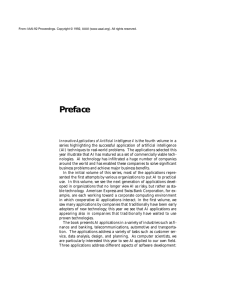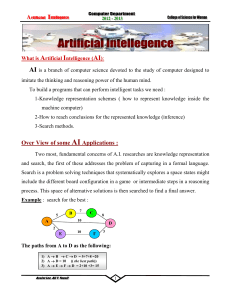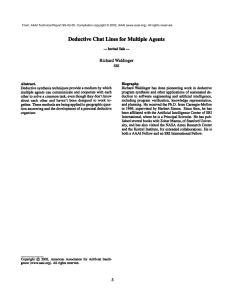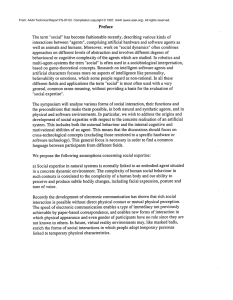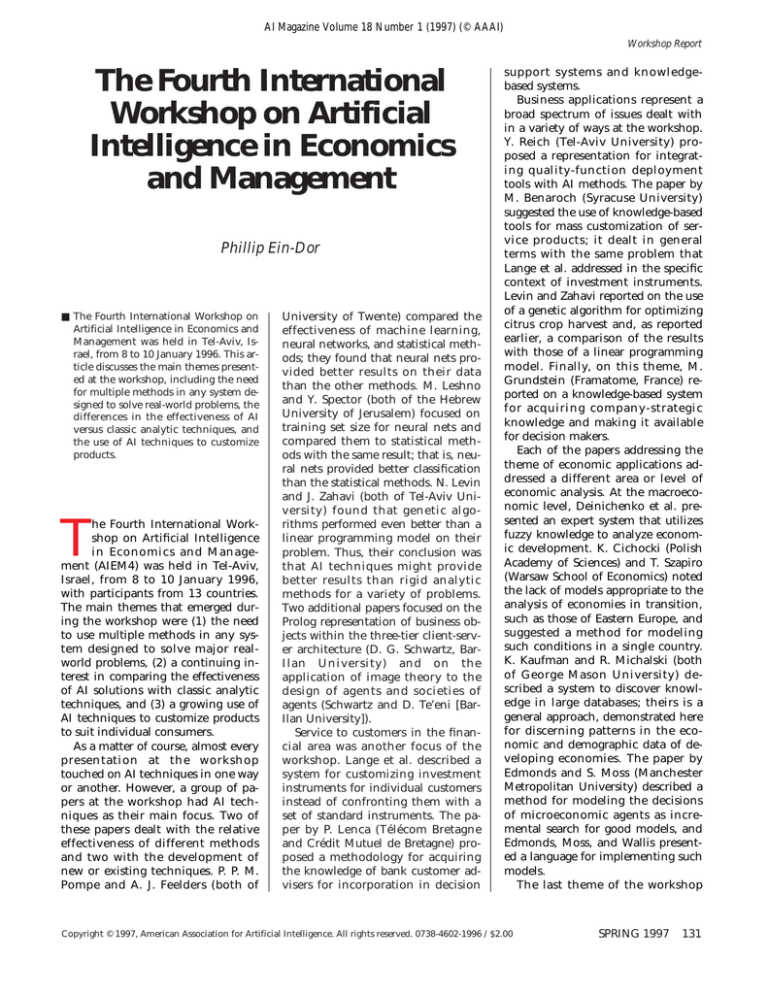
AI Magazine Volume 18 Number 1 (1997) (© AAAI)
Workshop Report
The Fourth International
Workshop on Artificial
Intelligence in Economics
and Management
Phillip Ein-Dor
■ The Fourth International Workshop on
Artificial Intelligence in Economics and
Management was held in Tel-Aviv, Israel, from 8 to 10 January 1996. This article discusses the main themes presented at the workshop, including the need
for multiple methods in any system designed to solve real-world problems, the
differences in the effectiveness of AI
versus classic analytic techniques, and
the use of AI techniques to customize
products.
T
he Fourth International Workshop on Artificial Intelligence
in Economics and Management (AIEM4) was held in Tel-Aviv,
Israel, from 8 to 10 January 1996,
with participants from 13 countries.
The main themes that emerged during the workshop were (1) the need
to use multiple methods in any system designed to solve major realworld problems, (2) a continuing interest in comparing the effectiveness
of AI solutions with classic analytic
techniques, and (3) a growing use of
AI techniques to customize products
to suit individual consumers.
As a matter of course, almost every
presentation at the workshop
touched on AI techniques in one way
or another. However, a group of papers at the workshop had AI techniques as their main focus. Two of
these papers dealt with the relative
effectiveness of different methods
and two with the development of
new or existing techniques. P. P. M.
Pompe and A. J. Feelders (both of
University of Twente) compared the
effectiveness of machine learning,
neural networks, and statistical methods; they found that neural nets provided better results on their data
than the other methods. M. Leshno
and Y. Spector (both of the Hebrew
University of Jerusalem) focused on
training set size for neural nets and
compared them to statistical methods with the same result; that is, neural nets provided better classification
than the statistical methods. N. Levin
and J. Zahavi (both of Tel-Aviv University) found that genetic algorithms performed even better than a
linear programming model on their
problem. Thus, their conclusion was
that AI techniques might provide
better results than rigid analytic
methods for a variety of problems.
Two additional papers focused on the
Prolog representation of business objects within the three-tier client-server architecture (D. G. Schwartz, BarIlan University) and on the
application of image theory to the
design of agents and societies of
agents (Schwartz and D. Te’eni [BarIlan University]).
Service to customers in the financial area was another focus of the
workshop. Lange et al. described a
system for customizing investment
instruments for individual customers
instead of confronting them with a
set of standard instruments. The paper by P. Lenca (Télécom Bretagne
and Crédit Mutuel de Bretagne) proposed a methodology for acquiring
the knowledge of bank customer advisers for incorporation in decision
support systems and knowledgebased systems.
Business applications represent a
broad spectrum of issues dealt with
in a variety of ways at the workshop.
Y. Reich (Tel-Aviv University) proposed a representation for integrating quality-function deployment
tools with AI methods. The paper by
M. Benaroch (Syracuse University)
suggested the use of knowledge-based
tools for mass customization of service products; it dealt in general
terms with the same problem that
Lange et al. addressed in the specific
context of investment instruments.
Levin and Zahavi reported on the use
of a genetic algorithm for optimizing
citrus crop harvest and, as reported
earlier, a comparison of the results
with those of a linear programming
model. Finally, on this theme, M.
Grundstein (Framatome, France) reported on a knowledge-based system
for acquiring company-strategic
knowledge and making it available
for decision makers.
Each of the papers addressing the
theme of economic applications addressed a different area or level of
economic analysis. At the macroeconomic level, Deinichenko et al. presented an expert system that utilizes
fuzzy knowledge to analyze economic development. K. Cichocki (Polish
Academy of Sciences) and T. Szapiro
(Warsaw School of Economics) noted
the lack of models appropriate to the
analysis of economies in transition,
such as those of Eastern Europe, and
suggested a method for modeling
such conditions in a single country.
K. Kaufman and R. Michalski (both
of George Mason University) described a system to discover knowledge in large databases; theirs is a
general approach, demonstrated here
for discerning patterns in the economic and demographic data of developing economies. The paper by
Edmonds and S. Moss (Manchester
Metropolitan University) described a
method for modeling the decisions
of microeconomic agents as incremental search for good models, and
Edmonds, Moss, and Wallis presented a language for implementing such
models.
The last theme of the workshop
Copyright © 1997, American Association for Artificial Intelligence. All rights reserved. 0738-4602-1996 / $2.00
SPRING 1997
131
Workshop Report
… their conclusion was
that AI techniques might
provide better results
than rigid analytic
methods for a variety
of problems.
concerns the perennial cognitive and
qualitative issues associated with AI.
R. Berndsen (De Nederlandsche Bank,
The Netherlands) addressed this issue
by describing a method for deriving
causal, qualitative explanations of
quantitative models. L. M. Botelho
(ISCTE, Portugal) and Coelho discussed the implementation of a model for explaining the motivations of
decision makers to search for and ignore information. The paper by L.
Dannhauser (Technikon Northern
Transvaal, South Africa) consisted of
a discussion of applications of AI to
training and education.
In summary, it appears that much
interesting and high-quality work,
both theoretical and practical, is being done on the application of AI to
economics, business, and management. We can look forward confidently to continuing progress in
this field in the near future.
uture software
will not merely
respond to requests for information but will anticipate the user ’s
needs and actively
seek ways to support the user. Such
software will also
manage cooperation among distributed programs. To describe the many
roles of this software, researchers
use the term agent.
F
The essays in Software Agents, by
leading researchers
and developers of
agent-based systems, address both
the state of the art
of agent technology
and its likely evolution in the near future. The introductory chapters in Part I present the views of proponents and a
critic of software agents. The chapters in Part II describe how agents are used
to enhance learning and provide intelligent assistance to users in situations
where traditional direct-manipulation interfaces alone are insufficient. The
chapters in Part III discuss agent-to-agent communication and the use of
agents to provide intelligent interoperability in distributed systems and the internet.
Contributors include Donald A. Norman, Nicholas Negroponte, Brenda Laurel,
Thomas Erickson, Ben Shneiderman, Thomas W. Malone, Pattie Maes, David
C. Smith, Gene Ball, Guy A. Boy, Doug Riecken, Yoav Shoham, Tim Finin,
Michael R. Genesereth, Craig A. Knoblock, Philip R. Cohen, Hector J.
Levesque, and James E. White.
Jeffrey Bradshaw leads the agent technology efforts for The Boeing Company
and the Fred Hutchinson Cancer Research Center in Seattle, Washington.
Phillip Ein-Dor is professor of information systems in the faculty of management, Tel-Aviv University. He is an associate editor of MIS Quarterly and a member
of the editorial boards of Information and
Management and Management Science and
Regional Development. His interests include
natural language processing, commonsense knowledge representation, business
applications of AI, information retrieval
from heterogeneous multimedia databases, and theory of information systems.
132
AI MAGAZINE
Published by The AAAI Press / The MIT Press
6” x 9” 500 pp. $40.00 paper
0-262-52234-9
Available in April from The MIT Press
To order, call 800-356-0343 (U.S. & Canada) or (617) 625-8569. Prices higher
outside the U.S. and subject to change without notice.
http://www.aaai.org/Press/Books/Bradshaw/

